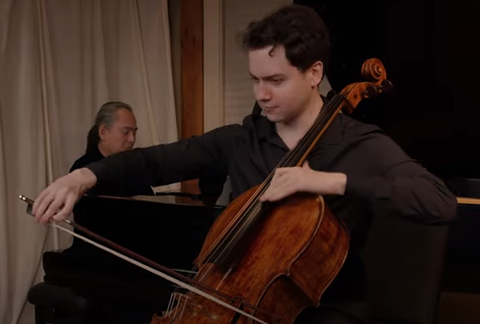Understanding the relationship between the bow and the voice is key to creating a singing line, as the cellist discovered while preparing his new album Voice of Rachmaninoff

Explore more Technique articles like this in The Strad Playing Hub
In preparing and recording my latest album Voice of Rachmaninoff I spent a great deal of time thinking more about the relationship between the bow and the voice. As string players in conservatory we are often taught that our goal should be to imitate the human voice. The naturalness with which we command our own voices is often the prime example in informing how we should shape a particular phrase. In the realm of string musicianship, the bow can be seen as an extension of the player’s breath, creating an individual musical expression akin to respiration. Like the lungs drawing in oxygen and releasing carbon dioxide, the bow collects potential energy as it’s drawn across the strings and releases it to form sound waves. This give-and-take relationship embodies the ebb and flow of musical phrases, transforming the bow into the musician’s lungs, and creating a rhythmic dynamic of inhalation and exhalation. Recognising this relationship is enlightening, but how can it translate into tangible improvements in musicianship?
Conscious Bow Control
The conscious control we exert over our breathing during activities like meditation or exercise can have significant benefits, and the same principle can be applied to bowing. Constantly consider the speed, pressure, and angle of your bow strokes, mirroring the conscious awareness applied to breath during mindfulness exercises. Often when teaching, I find that students focus heavily on achieving left hand proficiency in a given piece while the bow arm is ignored. This mindful approach to playing can foster enhanced control over your instrument’s sound and an enriched musical interpretation. This is something we can consciously experiment with in the practice room, but the awareness we develop translates to the dress rehearsal and the stage.
Grip Balance
Balance is as crucial in bowing as it is in breathing. In the respiratory process, excessive inhalation without corresponding exhalation can lead to hyperventilation. Similarly, a grip that is too tight or too loose on your bow can cause an imbalance in sound production. Strive to maintain a balanced grip on your bow during practice, allowing for optimal sound output. This balance mirrors the regulated rhythm of breathing, crucial for our body’s overall function. Use your practice time to perfect this grip balance and observe the impact it has on your sound. Using a mirror can be very helpful, but even a passing awareness of the amount of pressure there is between your fingers is better than autopilot.
In the respiratory process, excessive inhalation without corresponding exhalation can lead to hyperventilation. Similarly, a grip that is too tight or too loose on your bow can cause an imbalance in sound production
Sing while playing
Perhaps our most useful musical tool is our voice. Even an untrained voice has a very intuitive and natural way of singing almost any phrase. Actually singing out loud (and proudly!) should be one of the first steps we take when making musical decisions. It can also help us determine bowings and bow distribution. Despite being one of the most trumpeted suggestions in lessons and masterclasses, this simple tool is overlooked by many who are familiar with it. We get more accustomed to things the more we do them, so singing a little every day in the practice room is a great idea. If we want to go a step further, we can sing and play at the same time (slowly) to more deeply connect our bow with our voice. This is often a challenge of coordination, and so doing this with the bow in the air can be a useful intermediary step.
Read: Singing during practice can help improve sound and characterisation
Read: How harmonics and singing can help to build a sound technique
Create a Breathing-Bowing Exercise Routine
Creating exercises that synchronise your breath with your bowing technique can heighten your consciousness of both these processes. Try playing slow scales correlating your inhalation with an up-bow and your exhalation with a down-bow, or alternate this pattern. Another reality of the bow is that we have a sort of natural leverage towards the frog and a more artificial one near the tip. This of course makes a decrescendo more likely traveling toward the tip and a crescendo more likely traveling toward the frog. Reversing this as an exercise (crescendo towards the tip and decrescendo toward the frog) can be extremely valuable in giving us greater command over our bow.
Over time, all of these exercises combined can lead to a more relaxed and natural approach to your playing, while fostering a deeper connection between your breath and your bow.
Voice of Rachmaninoff is out on 9 June 2023 on Orchid Classics. Watch John-Henry Crawford and Victor Asuncion perform Rachmaninoff’s Rhapsody on a theme of Paganini, 18th variation:
Listen: The Strad Podcast Episode #51: John-Henry Crawford on Latin American music
Read: ‘If my cello could talk’ – by John-Henry Crawford
Explore more Technique articles like this in The Strad Playing Hub
The number one source for playing and teaching books, guides, CDs, calendars and back issues of the magazine.
In The Best of Technique you’ll discover the top playing tips of the world’s leading string players and teachers. It’s packed full of exercises for students, plus examples from the standard repertoire to show you how to integrate the technique into your playing.
The Strad’s Masterclass series brings together the finest string players with some of the greatest string works ever written. Always one of our most popular sections, Masterclass has been an invaluable aid to aspiring soloists, chamber musicians and string teachers since the 1990s.
This year’s calendar celebrates the top instruments played by members of the Australian Chamber Orchestra, Melbourne Symphony, Australian String Quartet and some of the country’s greatest soloists.













































No comments yet